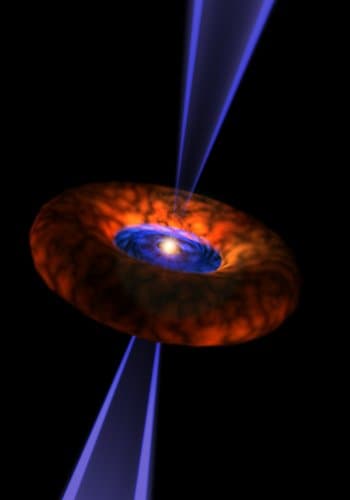Very heavy stars are formed in a similar way as their low-mass counterparts, conclude astronomers using the VLA radio telescope.

To shed light on the mystery of how massive stellar bodies form, researchers used the Very Large Array (VLA) radio telescope in New Mexico to study a young star (G24 A1), twenty times more massive than the Sun and situated about 25 000 light years away (Nature 443, 427).
According to theory, once a forming star has reached ten times the mass of the Sun, the intense radiation from its core should block the addition of any further material. As a result, although we understand the processes leading to the formation of smaller stars relatively well, the same cannot be said of massive stars.
There is a mystery as to whether massive stars form in a similar way to low-mass stars or whether a radically different processes are taking place, such as the merging of mid-sized stars.
Now, Maria Beltrán at the University of Barcelona and colleagues in Italy and Hawaii have found clues suggesting that heavy stars form in a comparable way to low-mass stars. “We have observational confirmation that massive star formation could be a scaled-up version of the process leading to the formation of solar-type stars,” Maria Beltrán told physicsweb.org. “Non-spherical accretion is a plausible way for stars with more than 10 times the mass of the Sun to accumulate mass.”
Low-mass stars like our Sun, are thought to form due to the collapse of a rotating gas cloud. This leads to the emergence of an accretion disk through which material is channelled into a central protostar. Beltrán and colleagues’ observation of the young massive star suggests that it could form by the ‘non-spherical accretion’ of material from giant toroidal (doughnut-shaped) gas cloud encircling it.
“For the first time, we have detected simultaneously in the same massive object material inward, material outward and rotation around the central massive star,” said Beltrán. “Besides rotating, the surrounding material is also falling into the central star.”
The researchers studied the emission of ammonia gas, at a frequency of 23 GHz, around the star; by detecting a Doppler redshift the team concluded that the material was falling towards the protostar (in this case, toward the observer). The team also found a blue-shifted absorption signal, indicating some material is also flung outward along the toroid’s rotation axis. At the same time, stellar radiation is able escape in beams at the star’s poles.
However, according to the team, the in-falling material could still be deflected into the outflow instead of being accreted – and as such, a direct observation of accretion is a challenge for the future. “There is still much more to do before we can have a complete picture of what is happening during the formation process,” said Beltrán. “We will continue to study G24 A1, and similar objects with even higher masses, in order to improve our understanding.”




